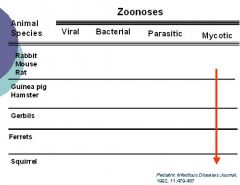![]()
![]()
![]()
Use LEFT and RIGHT arrow keys to navigate between flashcards;
Use UP and DOWN arrow keys to flip the card;
H to show hint;
A reads text to speech;
34 Cards in this Set
- Front
- Back
|
Pathogen that causes diarrhea and can be acquired via pools
|
Cryptosporidium
|
|
|
Diarrheal pathogen associated with Hamburgers and Hot dogs
|
E. coli O157
|
|
|
Diarrheal pathogen associated with Dips
|
Staphylococcus aureus
|
|
|
2 diarrheal pathogens associated with Cole Slaw
|
S. aureus
Listeria |
|
|
3 Diarrheal pathogens associated with Ice cream
|
S. aureus
Listeria Salmonella |
|
|
Diarrheal pathogen associated with Cheese cakes
|
S. aureus
|
|
|
Clinical sign of Giardia
|
very gassy and foul-smelling diarrhea
|
|
|
Agricultural and Slaughter practices have contributed to the emergence of these 2 pathogens
|
E. coli O157:H7
Campylobacter jejuni |
|
|
Epidemic that resulted from Bilgewater released from cargo ships in S. American fishing waters
|
Cholera
|
|
|
Pathogen that is present on Raw poultry, meat, unpasteurized milk
|
Campylobacter
|
|
|
Pathogen that can be found on Raspberries, untreated water, basil, and lettuce
|
Cyclospora
|
|
|
Pathogen that is found on ground beef, contaminated water, unpasteurized milk, sprouts, lettuce, unpasteurized juice and cider, and P-to-P contact
|
E. coli O157:H7
|
|
|
Creamy dressing = 1
Eggs, poultry, alfafa sprouts = 2 Ice cream, cold cuts, soft cheeses = 3 Raw shellfish = 4 Raw shellfish and drinking H2O = 5 Strawberries, clams, raw onions = 6 Drinking water = 7 |
1. S. aureus
2. Salmonella 3. Listeria 4. Vibrio 5. Calicivirus 6. Hepatitis A 7. Cryptosporidium parvum |
|
|
What gram - diplococci would cause bullous lesions and skin sloughing
|
Neisseria meningitidis
|
|
|
13 Most common infectious diseases associated with travel
|
1. Traveler's Diarrhea
2. ETEC 3. Malaria 4. Acute febrile respiratory tract infections 5. Hepatitis A 6. Gonorrhea 7. Rabies due to animal bites 8. Hepatitis B 9. Typhoid Fever 10. HIV 11. Legionella 12. Cholera 13. Meningococcal disease |
|
|
10 reported cruise ship outbreaks
|
1. Influenza A and B
2. ETEC 3. Legionnaire's disease 4. Rubella 5. Cyclospora 6. Shigella 7. Viral gastroenteritis 8. Norwalk virus (contaminated ice) 9. Norwalk virus 10. Shigella flexneri |
|
|
Pathogens that can be acquired from the salty sea
|
Vibrio cholera, parahemolyticus, vulnificus
*are salt tolerant* |
|
|
Pathogens that can be acquired from fresh water environments
|
Pseudomonas
Legionella Leptospira (a spirochete) |
|
|
List 4 bacterial agents associated with transmission by ticks
|
Borrelia burgdorferi = Lyme disease (Ioxodes)
Rickettsia rickettsii Francisella tularensis Erlichia chaffeensis |
|
|
Parasite associted with transmission by ticks
|
Babesia microti
|
|
|
5 diseases associated with Mosquitoes
|
WEE
EEE SLE Dengue West Nile Virus |
|
|
Most dog bites occur in this age group
|
children 9-10 yoa
|
|
|
Wound infections following dogs bites are commonly from these 3 bacteria
|
1. S. aureus
2. Streptococcus (alpha, beta, and gamma hemolytics) 3. Pasteurella species (gram -) |
|
|
Most cases of Pasteurella infections in humans are caused by this species
|
Pasteurella Multocida
-skin and soft tissue involvement -regional Lymphadenopathy |
|
|
Bacteria transmitted via turtles, snakes, lizards
|
Salmonella species
|
|
|
Bacteria transmitted by Parrots
|
Chlamydia psittaci
|
|
|
6 potential infectious agents transferred by close encounters with dogs
|
C. jejuni
Salmonella Leptospira interrogans Brucella canis Ehrlichia canis **CLEBS** |
|
|
Parasitic infections that can be transmitted by close encounters with dogs
|
Cryptosporidium
Isospora Toxocara canis Echinococcus granulosus Cutaneous larva migrans *CITE-C* |
|
|
Fungal infections that can be acquired by close encounters with dogs
|
Epidermophyton
Microsporum Trichophyton |
|
|
3 infections associated with inhalation from cats
|
Bordetella bronchiseptica
Yersinia pestis Coxiella burnettii |
|
|
2 bacteria acquired from vector-borne spread from cats
|
Ehrlichia
Bartonella |
|
|
3 infections acquired from fecal-oral spread from cats
|
C. jejuni
Toxoplasma gondii Salmonella |
|
|
3 infections acquired from cats via bite, scratch, or puncture
|
Erysipelothrix rhusiopathiae
Pasteurella multocida Francisella tularensis |
|

Fill in the blanks
|

*
|

